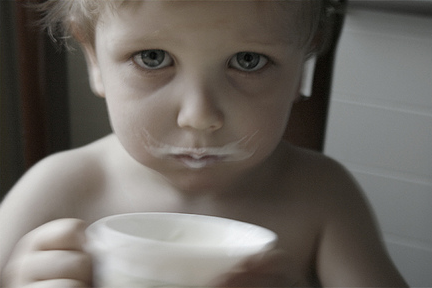Send your question to Umbra!
Q. Dear Umbra,
I am so sad! I just heard that dairy cows are impregnated and then the fetus is aborted so that we humans can have milk? What’s the best alternative? I don’t drink soy milk because of the toxins, subsidized farming, and because it’s heavily processed. Help!
Xoxi McCauley
Oakland, CA
A. There, there, Xoxi,
 Milk Fu Manchu got you down?Photo: Flickr via Davidoff AIt’s understandable to cry over milked milk. Just make sure you’re sobbing for the right reasons. Grab your handkerchief and hang on to your milk money.
Milk Fu Manchu got you down?Photo: Flickr via Davidoff AIt’s understandable to cry over milked milk. Just make sure you’re sobbing for the right reasons. Grab your handkerchief and hang on to your milk money.
When it comes to where our food comes from, many of us are in the dark. In his animal science textbook Contemporary Issues in Animal Agriculture, author Peter Cheeke actually crows about our ignorance. “One of the best things modern animal agriculture has going for it,” writes Cheeke, “is that most people … haven’t a clue how animals are raised and processed.” It’s time, Xoxi, for the hairy truth behind the milk moustache.
There are approximately 9 million dairy cows in the U.S. Every one of them is hard at work pumping out 1,816 pounds of milk per month, according to the USDA’s National Agricultural Statistics Service which, oddly, measures milk in pounds rather than gallons. But I digress.
The American dairy industry is thriving, despite certain troubling facts about its premier product (25 percent of Americans are lactose intolerant and milk contains pus, and makes you mucus-y). Milk, aka liquid meat, is second only to beef when it comes to making money for the livestock industry. The dairy industry milks its cows for all they’re worth, so to speak. And cows, our de facto wet nurses, don’t make a penny.
Like people, cows make milk to feed their young. To produce enough milk for human consumption, dairy cows are impregnated artificially. Like us, the gestation period for cows is 9 months; dairy cows give birth to one calf a year and are kept producing milk for most of their 9-month term. For maximum lactation, most dairy cows are pumped full of bovine growth hormone. Many end up with an udder infection known as mastitis.
Calf abortion isn’t the thing to cry over, Xoxi, because it’s not a common industry practice. What does happen to newborn calves may unsettle you more. The calves are taken from their mothers. Most females become milk machines like their mothers. Males wind up as veal or bob veal.
The lifespan for a typical cow is 20 years. The average milking cow is about four when she’s considered “spent” in industry terms. “There’s no retirement home for dairy cows. Nearly 100 percent of them are taken to slaughter for beef production,” says Paul Shapiro, Humane Society’s Factory Farming Campaign.
That’s right, Xoxi. Spent dairy cows end up on the dinner table. Oh, and the whole industry has a huge impact on the planet too. The factory farms, or Concentrated Animal Feeding Operations (CAFOs), are responsible for 18 percent of greenhouse gases worldwide. They’re also the cause of 64 percent of ammonia emissions, the primary cause of acid rain. And CAFOs are a leading contributor to soil and groundwater contamination.
You asked about alternatives. For the record, Xoxi, soy milk is not inherently toxic. You are right to be mindful with soy though. The majority of soy in the U.S. is genetically modified and requires massive amounts of pesticides to produce. What’s more, large swatches of rainforest are being destroyed to grow soy, which is bad for rainforest habitat and humans. So if you buy soy, look for USDA certified organic soy milk.
Another oy with soy is the controversy over whether soy mimics the hormone estrogen. Some say not to worry about this; others will tell you the opposite. My advice is practice moderation in all things. And don’t forget variety, the sign of a healthy diet. Macadamia milk, oat milk, hemp milk, rice milk, coconut milk, and almond milk are there waiting for you and your bowl of cereal.
You can even make your own. Moby, the vegan DJ, says it’s easy to milk an almond: “I just take almonds and water and put them in a blender for 45 seconds, and then strain out the chunks of almond.”
An added benefit of making your own milky white substance at home is that you’ll be cutting down on your processed/packaged food consumption. Here’s a great column to help you navigate alternative milks.
And if you aren’t completely soured on the idea of a cool glass of milk, there are worthy options. Look for dairy from animals who live in pastures instead of feedlots. It also helps to know your producer. Go here to find the local dairies with happier cows nearest you.
Finally, Xoxi, whether you do or don’t drink bovine, may your milk experiences be divine. I leave you with the words of playwright J. M. Barrie: “He who distributes the milk of human kindness cannot help but spill a little on himself.”
Udderly devoted to moo,
Umbra
Here are a few more lactose-inspired links for you:
- Lou Bendrick’s taste test of greener milks
- Tom Philpott on tainted meat brought to you by the dairy industry
- Happy cows and their dynamics.



